NJ Teachers of English to Speakers of Other Languages/
NJ Bilingual Educators
ARTICLES
From the Editor: Lisa Rose Johnson- Accepting the Mantle and Carrying the Torch
President: Caia Schlessinger- The GO TO Strategies
Vice President: Margaret Churchill- NJTESOL/NJBE 50TH Anniversary Conference
Past President: JoAnne Negrin- Keynote Speaker: Dr. Alfredo Quiñones Hinojosa
Socio-Political Representative: Elizabeth Franks- Advocacy Corner Update
Historian: Barbra Tedesco- Author, Author…New Jersey Authors on ELs historian
Exhibitor Liaison: Tina Kern- Gateway to Literacy
Representative-at-Large: Joyce Farr- Language Loss and Birth
Technology Coordinator: Marilyn Pongracz- Favorite Websites: Education.com
Guest Contributor: Jeffrey Linn- What does set mean?
See our Special Interest Groups Pages for More about English Learners of All Ages

From the Editor
Accepting the Mantle and Carrying the Torch
Lisa Rose Johnson, Ed.D.
Hello NJTESOL/NJBE members! I want to take this opportunity to first thank our executive board for the chance to become the new editor of Voices. I have graciously accepted the “mantle” as Roselyn Rauch has passed it on to me. Roselyn devoted a decade to Voices as the editor, and I am aware of the shoes that I need to fill. I humbly look forward to my new role within NJTESOL/NJBE, an organization that is near and dear to me as an ESL educator. Roselyn, and those that came before her, have paved the way to ensure that Voices and our organization will continue to advocate for students who are enrolled in ESL and Bilingual programs, and that mission continues today 50 years after it was formed.
As NJTESOL/NJBE celebrates its golden jubilee as an organization, I’d like to reflect on my own career as an introduction. My new role as the Voices editor and my career path as an ESL teacher occurred by chance. My teaching career began immediately following my graduating from Louisiana Tech University. After writing 30 full long form lesson plans a week as a student teacher, I was hired to teach special education in the school where I had completed my student teaching assignment. I successfully continued working in lower elementary classrooms in Lincoln Parish, Louisiana, before moving to New Jersey. After landing a job as a self-contained special education teacher in a middle school in Atlantic County, I eagerly wanted to return to my elementary school roots and teach phonics, and the basics of reading that are mostly absent at the middle school level. Moving to New Jersey, did have it benefits, it allowed me to acquire my first opportunity to train preservice teachers. I was hired to work at what is now Stockton University. I was hired as an adjunct faculty member to teach both online and face to face classes that led to a special education certification and a Master of Arts in Education degree. As if I was not busy enough, I also chose to enroll in course work at Stockton and earned my ESL and Supervisor endorsements to increase my marketability. As fate would have it, the ESL teacher at the middle school I worked at retired and I was approached to replace her due to my highly qualified status. I took the position in the ESL classroom and never looked back.
In 2008, I laid the groundwork for my doctorate by having a paper accepted at the Council for Exceptional Children’s National Convention in Boston on Generation 1.5 and the lack of supports and services that existed to meet the needs of this population. I carried this interest with me through my dissertation defense at Arcadia University. Since departing from Arcadia, I have had the opportunity to work in higher education settings at Mississippi State University-Meridian and for Rowan University. I work hard to continue to bring awareness and advocate for students from marginalized populations on a state and national level including students with disabilities, students with interrupted educations, immigrants, and dual language learners as well as Generation 1.5 students.
Lisa Rose Johnson is the Teacher Education Representative and works at Rowan University.
President
The GO TO Strategies
By Caia Schlessinger
 As the President of NJTESOL/NJBE, I represented our organization, which is a TESOL International Organization affiliate, at the 2019 TESOL International Convention and English Language Expo in Atlanta Georgia in March. The schedule was full of Preconvention Institutes, Educational Site Visits, Doctoral Research Forums, Master’s Student Forums, Keynotes, Affiliate Meetings, Poster Sessions, Technology Exhibits, and workshops. I attended the Convention for four of the six days.
As the President of NJTESOL/NJBE, I represented our organization, which is a TESOL International Organization affiliate, at the 2019 TESOL International Convention and English Language Expo in Atlanta Georgia in March. The schedule was full of Preconvention Institutes, Educational Site Visits, Doctoral Research Forums, Master’s Student Forums, Keynotes, Affiliate Meetings, Poster Sessions, Technology Exhibits, and workshops. I attended the Convention for four of the six days.
I was fortunate to be able to attend one of TESOL’s well planned PCIs (Preconvention Institutes), which was a seven hour day during which I attended a workshop ‘Planning for the Success of ELLs in Academic Content Classes: What Works?’ presented by Giselle Lundy-Ponce, Susan Lafond, Areli Schermerhorn, and Becky Corr. During the PCI, the presenters included time to review and explore the ‘The GO TO Strategies: Scaffolding Options for Teachers of English Language Learners, K-12’. This document is the result of Project EXCELL professional development delivered to the North Kansas City Schools teachers and was written by Dr. Linda New Levine, Ms. Laura Lukens, and Dr. Betty Ansin Smallwood.
The document includes 78 strategies that were modeled and discussed with the North Kansas City teachers. The GO TO Strategies are meant to be a resource for K-12 general education and content-area teachers with English language learners (ELLs) in their classrooms, ELL teachers, special education teachers, principals, supervisors and for professional development of these educators.
The GO TO Strategies includes a Matrix, which consists of chart similar to the WIDA Can Do descriptors with boxes intersecting English Language Proficiency (ELP) and the four domains. In each box, there are exemplary strategies for that particular ELP level and domain. The strategies can be modified by teachers for students at other proficiency levels. There is also a table of contents and glossary, which helps the reader to quickly find the needed information.
I was also able to attend an almost two hour workshop on the ‘GO TO Strategies’ by the team of educators that designed them. During their presentation, they linked the ‘GO TO Strategies’ to a new TESOL Press book ‘The 6 Principles for Exemplary Teaching of English Learners, Grades K-12’. One of the authors, Dr. Linda New Levine, was a co-author of the TESOL book and the Strategies document. The presenters demonstrated how the ‘GO TO Strategies’ supported The 6 Principles, which are:
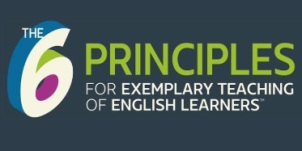 Know your learners.
Know your learners.- Create conditions for language learning.
- Design high-quality lessons for language development.
- Adapt lesson delivery as needed.
- Monitor and assess student language development.
- Engage and collaborate within a community of practice.
Overall, attending the TESOL Convention was extremely beneficial not only for my role as President of NJTESOL/NJBE, but as a classroom teacher. The TESOL 2020 International Convention is scheduled for March 31st – April 3rd in Denver, Colorado. If you are not yet a member of TESOL International, you can join here.
Caia Schlessinger, President, NJTESOL/NJBE; ESL Teacher, Highland Park School District cschlessinger@njtesol-njbe.org
 Vice President and Conference Chair
Vice President and Conference Chair
NJTESOL/NJBE 50TH Anniversary Conference
By Maggie Churchill
NJTESOL/NJBE is pleased to announce the keynote presenters for our 2019 annual conference: Celebrating the Success of Bilingual, Dual, and English Language Learners. Please note the start times of the keynotes and breakout sessions.
Wednesday, May 29th at 8:30 a.m. Lisa Tabaku, Director of Global Languages and Culture, the Center for Applied Linguistics (CAL) A 21st Century Challenge: Effectively Serving Students with Interrupted Formal Education This presentation will address the academic and biological-social-emotional needs of students with interrupted formal education (SIFE), with supports that can be provided by schools and teachers.
Breakout session at 11:30 on Using the Guiding Principles for Dual Language to Inform Dual Language Program Development and Enhancement Relying on research that has been gathered to date, this interactive workshop will acquaint participants with the fundamentals that every dual language program must consider in order to be successful. The content of the session relies on the revised publication, now 3rd edition, of the Guiding Principles for Dual Language Education.
Thursday, May 30th at 8:30 a.m. Madeline Mavrogordato, PhD, Associate Professor Department of Educational Administration, Michigan State University Closing Opportunity Gaps for English Learners: Data, Decisions and Dedication English learners face large and persistent opportunity gaps. Drawing upon cutting-edge research, this presentation will challenge educators to reframe the way they think about the EL achievement gap, disaggregate data to better support ELs, and leverage policy to expand educational opportunity for EL students.
Breakout session at 10:00 a.m. on Engaging Families to Expand Equity for English Learners Engaging the families of EL students is a critical component of the quest to expand educational equity for EL students. Yet, parents of ELs are all too often relegated to the sidelines and seen as a liability rather than an asset. This presentation will challenge widely held assumptions about the families of ELs and draw upon current research to explore how educators can cultivate a linguistically and culturally responsive system of parent engagement.
Friday, May 31st at 11:30 a.m. Alfredo Quinones-Hinojosa, MD, Chair of Neurologic Surgery, Mayo Clinic Jacksonville, Florida Building bridges, finding cures, giving hope Dr. Q. retells his astonishing journey from migrant farm worker to renowned surgeon, scientist, innovator and philanthropist is full of stories. In this keynote, Dr Q. will share the stories that demonstrate the importance of building bridges and the ways that bridges sustain and enhance our lives. His journey is a reminder that each student is full of potential and it is our joint responsibility to build bridges to them so that they have futures worth hoping for. Whether it is bridging resources through his global missions or bridging ideas in the lab using STEM cells to find a cure for cancer, Dr. Q. uses bridges to find cures and give hope.
Breakout Session at 1:00 p.m. Walk the Bridge with Me – a moderated conversation with NJTESOL/NJBE Past President, JoAnne Negrin
Maggie Churchill is the Vice President and Conference Chair of NJTESOL/NJBE.
Past President
Keynote Speaker: Dr. Alfredo Quiñones Hinojosa
By JoAnne Negrin
 It is hard to believe that another Spring Conference is around the corner. This will be the seventh Spring Conference that I have had the pleasure to work on. I have seen the event go from two days to three and become a very polished and professional event. You would never know that the vast majority of the hours that are put into it are volunteer hours! The conference has also evolved from being the focus of our Executive Board’s efforts to an engine for the development of professional expertise and the generation of revenue that allows our organization to support education, outreach, and advocacy projects statewide and to have a larger voice in shaping policy.
It is hard to believe that another Spring Conference is around the corner. This will be the seventh Spring Conference that I have had the pleasure to work on. I have seen the event go from two days to three and become a very polished and professional event. You would never know that the vast majority of the hours that are put into it are volunteer hours! The conference has also evolved from being the focus of our Executive Board’s efforts to an engine for the development of professional expertise and the generation of revenue that allows our organization to support education, outreach, and advocacy projects statewide and to have a larger voice in shaping policy.
As we celebrate the 50th anniversary of NJTESOL/NJBE, we continue to actively look for ways to meet the needs of our constituents. You will see a number of innovations and celebrations this year, in a conference that is bigger and better than anything we’ve ever done. On Friday, May 31, we will have the honor of hosting Dr. Alfredo Quiñones Hinojosa, who often goes by the nickname Dr. Q. He will talk to us about his unlikely rise from migrant farm worker and undocumented immigrant to a preeminent neurosurgeon seeking a cure for an aggressive form of brain cancer. His story is a reminder to each of us never to set limits on a person’s future based on where he or she is today. We want a Dr. Q-style success for every student.
Dr. Q.’s passion is providing specialized health care to underserved communities. In his honor, we are also focusing that day on partnerships between community health care providers and schools. Very often, ESL and Bilingual teachers are the first to gain the confidence of our ELL families. They are often the first to learn of a health crisis, and they may not know where to turn for help. This situation has worsened in the current political climate in which many immigrant families are afraid to seek help. We will have presentations from New Brunswick Public Schools on “Community Asset Mapping.” They will discuss how they were able to construct and develop partnerships with community organizations to benefit students’ physical, social, and emotional well-being. We are also pleased to have a workshop from the Cherry Hill Public Schools about their collaboration with Behavioral Health/Children’s Hospital of Philadelphia (CHOP). They devised an online quiz for parents and students that routes them into a multitiered system of support, or provides reassurance that their teen is experiencing normal development. The system allows them to seamlessly manage interventions based on a student’s risk scores. There may be additional workshops added to address the very important issue of our students’ physical and emotional health.
I look forward to seeing you in New Brunswick as we celebrate 50 years and embrace our opportunity to provide even better services for the next 50.
JoAnne Negrin Past President, NJTESOL/NJBE Supervisor of ESL, Bilingual Education, World Languages, & Performing Arts Vineland Public Schools Chair, NJPSA ELL Committee
Socio-Political Representative
Advocacy Corner: Update
By Elizabeth Franks
 As always, we have been very busy staying informed and reaching out on behalf of our students and their families.
As always, we have been very busy staying informed and reaching out on behalf of our students and their families.
We hope that you can join us at the 2019 Advocacy Summit, entitled Advocating for Diverse Learners. It will be held on May 29th at 4 PM at the Hyatt in New Brunswick. Please pre-register at https://njtesol-njbe.org There is a $10 fee which supports our scholarships. We are excited to share with you this dynamic, exciting panel: Carolyn Marano, the Assistant Commissioner for Student Services, who will discuss how to train parent advocates; Yasmin Hernandez-Manno, Mercer County Superintendent, will address Advocating for the SIFE; Nagla Bedir, Social Studies teacher in Perth Amboy Schools will discuss “Teaching While Muslim” and finally Assemblyman Jamel Holley from Union County will share ideas of advocacy through legislation. Assemblyman Holley was one of the co-sponsors of the law which mandated the NJDOE to create guidelines for identifying English learners for Gifted and Talented programs. A Q & A will follow the panel. In addition, we will honor our Seal of Biliteracy Superintendent of the year, Dr. John Ravally from Franklin Township Public Schools. So bring your passion and questions to the Summit! This is your chance to educate and advocate our leaders.
In case you did not receive the information, the NJ DOE has published the Guidance for ELL Entry and Exit effective 7/1/19 according to the ESSA plan . The executive board plans to ask the NJDOE for more clarity on the guidelines for ELs with Special Needs. We specifically want to advocate that an ELL specialist is a part of the decision-making committee for both entry and exit. Members also had concerns on how the home language survey will be administered. Please reach out to the Bilingual Office on any questions or concerns that you have.
On April 1st (this was not a joke) Joanne Negrin, Barbara Tedesco and Elizabeth Franks met with several administrators in the Department of Education. They included: Carolyn Marano, Assistant Commissioner for Student Services; Peggy McDonald, Deputy Commissioner for Student Services; Diane Pasculli, Deputy Commissioner for Assessment; AbdulSaleem Hasan, Deputy Commisioner for Field Services and Colleen Schulz-Eskow, Deputy Chief of Staff. The goal was to request that New Jersey create a language arts assessment in Spanish since that language has met the threshold set on the ESSA plan. In addition, NJTESOL/NJBE requested that the NJDOE request more valid accommodations in the new iteration of assessments; i.e. more visuals, sheltered English, glossaries, etc. The representatives from NJTESOL/NJBE have followed up the meeting with resources on other states that assess language arts in Spanish as well as the research on valid and reliable accommodations for ELs on standardized tests.
NJTESOL/NJBE continues to advocate on the shortage of bilingual teachers and the expansion of preschools for Dual Language Learners. On the website, you will find a document which was shared with our colleagues at the various colleges and universities on ways that they can help address this shortage. We also wrote a letter to our legislators supporting Governor Murphy’s budget proposal to expand the funding for preschool programs. Research from NIEER clearly demonstrates that high quality preschool programs help to close the achievement gap for DLLs.
Another initiative which NJTESOL/NJBE supports is increasing ELs’ participation in the Seal of Biliteracy. After the webinar sponsored by Rutgers GSE, we spoke with representatives from the bilingual and World Language offices on ways to achieve this goal. Some of the suggestions include: a transparent report on demographic participation; create a warehouse for low incidence languages, encourage vendors to create assessments for more languages; and to collaborate with other states and share assessments.
In conjunction with NJPSA, we co-hosted a webinar on Special Education and ELLs. NJTESOL/NJBE is fully committed to beginning and continuing dialogue and presentations on this topic at the NJPSA conference, plus a full day workshop on the topic. We must continue to ask the NJDOE and state legislators to develop guidelines for ELs and Special Education. If you are interested in serving on a subcommittee on this topic please contact BJ Franks at efranks@njtesol-njbe.org
NJTESOL/NJBE is also looking for volunteers to help us address the increase in the enrollment of Students with Interrupted Formal Education (SIFE) and the services that they receive (or not). We want to explore ways that we can better advocate for this very vulnerable population. Please reach out to BJ Franks if you would like to be more involved.
Legislatively, there are the current bills that require our attention:
- A-2437, which establishes a grant program for Dual language Immersion, is languishing in the Assembly Education Committee. This bill will provide funding for districts to establish and develop Dual Language Education It passed Senate last February and needs to be voted out of the Assembly Education committee. We need to contact Assemblywoman Lampitt, Chair of the Education Committee and urge her to post the bill for a vote. Contact information can be found at our website: https://njtesol-njbe.org/advocacy/
- Federally, Reach English Learners Act was reintroduced (HR1153) that will establish a grant program to fund certifying more teachers to work with ELs. We have NO NJ legislators as co-sponsors. Please write to your Representative and Senators and urge them to co-sponsor the bill. Let them know that the EL population in NJ is growing and we need more ESL certified and Bilingual certified teachers. NJ would definitely benefit from this grant program. Check https://njtesol-njbe.org/advocacy/ for contact information.
- Another bill has been in Committee HR1239 World Language Advancement and Readiness Act of 2019.“The Secretary of Defense, in consultation with the Director of National Intelligence and the Secretary of Education, shall carry out a program under which the Secretary of Defense makes grants, on a competitive basis, to State educational agencies and local educational agencies to pay the Federal share of the cost of innovative model programs providing for the establishment, improvement, or expansion of world language study for elementary school and secondary school students.
Stay informed, stay involved. Our students and their families need YOU to help them to advocate. Get involved in your chapter, come to the ADVOCACY SUMMIT!
Elizabeth Franks is the Advocacy Representative of NJTESOL/NJBE.
Historian
Author, Author…New Jersey Authors on English Learners (ELs)
By Barbra Tedesco
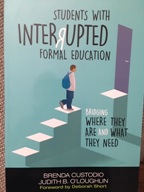 As part of my series in celebrating 50 years of NJTESOL/NJBE, my focus for this issue is about people in NJ who have authored or co-authored books in our field. Over the years I have tried to compile a list of these authors which I share with you now.
As part of my series in celebrating 50 years of NJTESOL/NJBE, my focus for this issue is about people in NJ who have authored or co-authored books in our field. Over the years I have tried to compile a list of these authors which I share with you now.
Authors are those who conduct extensive research, collaborate, are disciplined and have patience to put the finished product to rest. It can be frustrating because of re-writes, edits, and improvements. They are voracious readers who are absorbed in a sea of words. I have read their books which are now in my library and offer my thanks to these individuals.
The list is alphabetical by author and the New Jersey author, if co-authored at the time of the writing, is in bold. If anyone can add to the list, please email me at babted13@gmail.com. and I will make sure it is archived and posted on our hotlist as an acknowledgement.
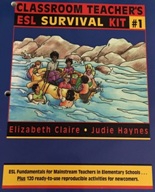 Pam Brillante and Karen Nemeth – Universal Design for Learning in the Early Childhood Classroom
Pam Brillante and Karen Nemeth – Universal Design for Learning in the Early Childhood Classroom- Diego Castelllaños – The Best of Two Worlds: Bilingual-Bicultural Education in the U.S
- Angela Carrasquillo and Vivian Rodriguez – Language Minority Students in the Mainstream Classroom
- Clyde Coreil and Mihri Napoliello, Editors – NJCU The Journal of the Imagination
- Brenda Custodio & Judith B. O’Loughlin – Students with Interrupted Formal Education: Bridging Where They Are and What They Need
- Jean D’Arcy Maculaitis – What to Do Before the Books Arrive and The MAC or Assessment of Competencies: English Language Proficiency Evaluation
- Tess Feree & Kim Sanabria – North Star, Listening and Speaking
- Barbara H. Foley and Elizabeth R. Neblett – English in Action Series
- Judie Haynes – • Teaching English Language Learners Across the Content Areas • Getting Started with English Language Learners: How Educators Can Meet the Challenge • Newcomer Program, Grades K-2
- Judie Haynes & Elizabeth “Betty” Claire – Newcomer Program, Grades 3-6, Classroom Teacher’s ESL Survival Kit #1, Classroom Teacher’s ESL Survival Kit #2
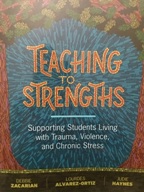 Judie Haynes & Debbie Zacarian -Teaching English Language Learners: Across the Content Areas
Judie Haynes & Debbie Zacarian -Teaching English Language Learners: Across the Content Areas- Fred Malkemes & Deborah S. Pires – Looking at English ESL Text-Workbook for Beginners I, II, III
- John Klosek & Donald H. R. Byrd – Can we talk?: A Multiskills Approach to Communication
- Karen Nemeth – Many Languages, One Classroom: Teaching Dual and English Language Learners; Many Languages: Teaching Dual and English Language Learners; Building Connections; Basics of Supporting Dual Language Learners; Basics of Supporting Dual Language Learner; Dual Language Learners: A Guide for PreK -3 Leaders; and many more
- Karen Nemeth and Ana Lomba – Mi habitación/ My Room (Bilinguial Smart: Toddlers)
- William P. Pickett – The Chicken Smells Good: An ESL Reader and The Pizza taste Great: Dialogues and Stories
- Howard Pomann (co-authored with Gretchen Dowling) – Lifelines I, II, III, IV
- Deborah Singer Pires and Susan C. Khodabakhshi – Grammar Write
- Armando Riverol – The Action Reporter as well as a non-ESL Book entitled Live from Atlantic City: A History of the Miss America Pageants
- Debbie Zacarian & Judie Haynes – The Essential Guide for Educating Beginning English Learners
- Debbie Zacarian, Lourdes Alvarez-Ortiz, and Judie Haynes –Teaching to Strengths: Supporting Students Living with Trauma, Violence, and Chronic Stress
- Hope to see your name added to my future list.
Barbara Tedesco, Co-Manager of LLAMAME and NJTESOL/NJBE Historian
 Exhibitor Liaison
Exhibitor Liaison
Gateway to Literacy
By Tina Kern
The students enter the room and take their seats. I hear a little chatter in Spanish and Mam, and at times some Spanglish. Some remember to get their folders; others wait until the bell and scramble to gather their materials. Still others are more casual and wait until the last minute. I take a moment to reflect upon the obstacles my students have overcome. I look again and see them. Now we are a community that has come together for a Bilingual Language Arts class.
My classes span a plethora of proficiency levels. Some students speak no English and, in addition, are SLIFES. Others speak some English and have some literacy skills in Spanish. Others can have a conversational in English, yet cannot write a paragraph or essay in English. Some of my students have never been in a Language Arts classroom, while some students have received minimal education. A small group of other students is continuing their education without a gap in their educational past. Together we share a journey that will add a dimension that our ESL classes were not able to include in one course– the intricacies of the written language. We go beyond the conversational to the formal expression of language. We are conquering the skills that make us more literate. This year some of our students will graduate with the Seal of Biliteracy!
Previously our students struggled to conquer English and be successful in all of the domains. In high school one of our challenges is that our students often enter our school at the age of 17, 18, or higher. We have a limited amount of time to arm the students with the skills necessary to complete graduation requirements, let alone be ready to continue their education at a higher level. Because of the various skill levels and educational background, some students found it difficult to integrate their skills in order to create a basic essay. As a result, when our students entered a new phase in their lives, after they received their diploma, they found their skill base in reading and writing lacking and weren’t able to produce essays and read dense material with close reading comprehension. As a result, some found themselves accepted to County College but didn’t pass the language exams. They were required to enroll in ESL or remedial courses (for “no credit), taking time from their ultimate goal. Even some students that had “proficiency” on the ACCESS were unable to produce adequate writing samples.
Now, with the creation of Bilingual language art classes, we are graduating more literate bilingual learners who are able to be successful in our competitive world. We are giving the students the tools to flourish and become confident. By offering them a variety of literary experiences, by providing a gateway to literacy, we are propelling the students forward to a new higher level of understanding. I marvel when I reflect on the first ESL/Bilingual students I met just about four years ago, some of which fought their nightmares daily as they attended our classes. With time and understanding, we are creating a community and a team with the same goal. It still is a difficult journey, but we are moving forward.
This year our students in the high school take ESL and Bilingual Language Arts every marking period. The additional time devoted to reading and writing boosts the students’ knowledge of English so that they can actually feel confident when asked to read fiction and nonfiction selections, or write a five paragraph essay. Alberta Education as “the ability, confidence and willingness to engage with language to acquire, construct and communicate meaning in all aspects of daily living defines literacy.” By providing ESL and Bilingual Language Arts classes to each ELL schedule, we double their interaction with the English language in all domains.
At this time, the Bilingual ELA curriculum is distinct and has more in common with the progression of the ESL courses, than the regular Language Arts curriculum. For example, if a student enters the school as an 11th grade student, and their proficiency level is English beginner, they enter the Bilingual Language Arts 1 class. The WIDA English Language Proficiency levels and other factors are used for their placement in the various classes in Bilingual ELA. .For example, the Bilingual Language Arts 4 classes are taught in English (with, of course, the option of Spanish for clarification), and so only students with a higher English proficiency in the four domains should be enrolled for those classes. The distinction between Bilingual ELA and regular content areas is that the curriculum must be adapted to not only the content material, but also the level of English, similarly as their placement in ESL classes.
I am always looking for new methods and materials for my LA classes. In March, I attended NABE and was energized and ready to integrate new ideas as soon as possible. I was thrilled to find other teachers constructing, deconstructing and reconstructing lessons for our students. One disappointment, though, was the lack of middle school and secondary workshops that attended to our needs with our teenagers. Our challenges are unique as we are charged with a limited amount of time in which in teach so many topics. About this time of year, when testing seems to overwhelm the calendar; I start to hear the ticking clock. I am sure you do, too.
Also, I visited some of the exhibitor booths at NABE. I greeted our “friends”, those that already participate at our conference by sharing their materials, and also met new exhibitors, some of whom will be joining us this year. I was especially thrilled to see the new books and material created in two languages. For those of you – like me- who are always looking for the next “perfect” solution, there will be a significant amount of material for you to peruse! Please extend your thanks to our exhibitors as you visit them at our conference in May.
We are all looking forward to our NJTESOL/NJBE Spring Conference. I feel a bit of pride being part of an incredible organization that is cELLebrating 50 years! I know our workshops are inclusive of all levels and diverse topics. I am looking forward to sharing what I have learned now after having created and taught Bilingual Language Arts classes. Teaching literacy is crucial to the success of our ELLs. I can’t wait to talk to you and share ideas that can be adapted and utilized in your classrooms.
I am pleasantly surprised by how my students have embraced the Language Arts classes. Otherwise, resistant students began to be drawn into the discussions and lessons that gave them the power to master and construct sentences and paragraphs, and use close reading to comprehend those clusters of words that previously seemed to be an insurmountable task. Sometimes when I sit with them at the tables and look up with pride into their unreadable faces. I see them erupt into smiles, and react with pride as I say, “You did it!” That, my friends, is the priceless gift of being a teacher of ELLs.
I’m looking forward to seeing you at our NJTESOL/NJBE Spring Conference. Until then….
Tina Kern, Exhibitor Liaison
Representative-at-Large
Language Loss and Birth
By Joyce Farr
February 21st marked International Mother Language Day. I acknowledge its value and the sacrifices made as I celebrate the beauty of the human spirit, embodied in our culture and expressed through human language, the language whispered into our ears as babies and transmitted generation after generation. According to explorer and anthropologist Wade Davis, “Every language is an old-growth forest of the mind, a watershed, a thought, an ecosystem of spiritual possibilities.”
 Yet on another level, to some extent, I grieve a personal loss. I don’t remember that singular moment or day when a decision was made on my behalf, so many decades ago upon starting first grade, but it happened and my identity and my soul were both colonized by a foreign tongue, or to be exact, two new languages. Over time, almost imperceptibly, through an indescribable process of translanguaging, code switching, continuous self-discovery and reinvention, I finally crashed into a wall of profound silence when I faced the inexorable truth that I could no longer conjure up, create, shape, color and paint thoughts, dreams and hopes in the pictographs of my mother tongue.
Yet on another level, to some extent, I grieve a personal loss. I don’t remember that singular moment or day when a decision was made on my behalf, so many decades ago upon starting first grade, but it happened and my identity and my soul were both colonized by a foreign tongue, or to be exact, two new languages. Over time, almost imperceptibly, through an indescribable process of translanguaging, code switching, continuous self-discovery and reinvention, I finally crashed into a wall of profound silence when I faced the inexorable truth that I could no longer conjure up, create, shape, color and paint thoughts, dreams and hopes in the pictographs of my mother tongue.
Despite years of weekly hourly Chinese lessons, that were tortuous and laborious for both tutor and tutees, I failed to appreciate the impending crisis that was about to befall the multilingual younger version of me, the child that once was bequeathed three personal monosyllabic names at birth. With immigration, those names, rich with meaning and identity, have now been swallowed up and permuted into two anglicized names. Yes, I remain bilingual and biliterate in my second and third language, but I have stumbled my way around like a lost foreigner in the various dialects of my first language and even Mandarin (普通话). It is important to note that although the same written characters are commonly comprehensible by all the Chinese language groups, the spoken forms are to a great extent, mutually unintelligible to non-speakers of the dialect. I wonder what my bilingual and emerging bilingual students must be undergoing in this new ethnosphere where their heritage and indigenous cultures face the threat of relegation. What plight might these culturally and linguistically colorful beings find themselves in as English is increasingly touted as the dominant language, the language of education and of power?
Today, according to Ethnologue, over 1 billion people speak Chinese, the most spoken language in the world, followed by Spanish and English. But what of the thousands of languages other than these? As the World Language and ESL Departments in my building hastily planned and organized its inaugural National Foreign Language Week event, A Taste of the World, I reflected on whether we were in fact celebrating world languages as foreign languages, as opposed to heritage languages, those languages that shed insight into the beautiful diversity that inhabit the spaces of our classroom. In 2017, at TESOL International, I was introduced to English Across the Fracture Lines, to which I hadn’t paid much attention until now, and how the teaching of the English language has contributed to social cohesion as well as the erosion of cultural identities, to the extent of inciting division, exclusion, conflict, violence and fractures across communities. While ELT (English Language Teaching) is intended to foster international communication, to promote intercultural understanding, to confer access to knowledge, and to create opportunities as it opens doors, it inadvertently, or dare I say, intentionally, also replaces or relegates the mother languages. From my immigrant and multilingual vantage point, English language competence has afforded me privileges but it also highlights the disparities between my experience and that of the children and youth who are learning English in my classroom. How, in a country that has politicized language, does a language educator such as me, use English to build bridges across those fissures, to build hope, to build community, to build an equitable nation and to build an enduring ecosystem of possibilities?
Joyce Farr, NJTESOL/NJBE Representative-at-large, NJEA Liaison
Technology Coordinator
Favorite Websites
By Marilyn Pongracz
Education.com
Education.com is a website with 30,000 online and printable resources for teaching students in Pre-K- to grade 5. You can choose whatever you need, and you will find many that are suitable for ELLs that also align with the classroom curriculum that you need to reinforce. Printable worksheets predominate, but there are also lesson plans, online games, hands-on activities, interactive stories, online exercises, science projects, and song videos.
While the number of free monthly downloads (about five) is very limited, not every resource has to be downloaded, and the cost of a subscription for is low: $8 for one month, $5 per month for one year ($60), or a lifetime fee of $160.
Searching for resources is very user-friendly. You can use the search tool or browse by grade, topic, and/or subject, including math, science, reading and writing, fine arts, social-emotional awareness, social studies, and typing. You can also sort the results of your choices by popularity, highest rated, most recent, title, or relevance.
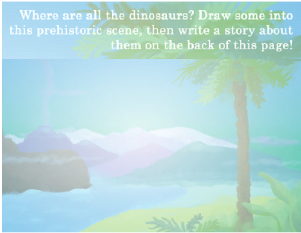 Worksheet Sample – Dinosaur Writing Prompt
Worksheet Sample – Dinosaur Writing Prompt
- Grade: First Grade
- Subject: Reading & writing
- Genre: Writing
- Narrative: Writing
- Common Core Standards: W.1.3
Related learning resources (listed on the website.)
- There are sentence completion worksheets that could be suitable for beginning ELs. The fifth grade science: vocabulary in the worksheet below is probably manageable if pre-taught.
- The Lesson Plans are created by teachers with detailed instructions, from objectives through introduction, instruction, modeling, activities, differentiation, assessment, and review.
- You can find the worksheets in the lesson plans through a search, but downloading them directly from the lesson requires a paid subscription. Games (not free) – are sorted by grade and topic, and are accessible through the Education.com Kids app. They work on all types of devices. The screenshot below is a sampler of the variety of games.
- Science projects and hands-on activities can be viewed online, but the other options: interactive stories, online exercises, and song videos require a subscription.
The variety of resources on Education.com, if they suit the needs of your students, may be worth the cost of a subscription.
Marilyn Pongracz is the Technology Coordinator for NJTESOL/NJBE and the English Language Resource Center Supervisor at Bergen Community College. tech1@njtesol-njbe.org
Guest Contributor
What does set mean?
By Jeffrey Linn
What does set mean?  A struggling student of English might Google it, and find 20 or so definitions in an entry of over 1700 words, with 50 to 60 example sentences and a plethora of synonyms that branch out into divergent semantic territories.
A struggling student of English might Google it, and find 20 or so definitions in an entry of over 1700 words, with 50 to 60 example sentences and a plethora of synonyms that branch out into divergent semantic territories.
The standard algorithm of dictionaries is to present the most common definition first, so quite often the initial glance saves the day. But when that isn’t it, we must scroll down into a multi-tiered cellar and shine a light on the things we encounter, hoping to find a match. Googling the entire phrase might be an easier route to comprehension.
But, if we could posit an invariant core meaning of set, we could test to see if messages in context are easily inferred in various usages (a Columbia School Linguistics approach, tandfonline link below). If this works well, we can then present this core meaning of set to students and provide some practice in the process of inferring messages.
One of the first things we can observe about set with a glance at the etymology online entry is that it is at least two distinct words, one Germanic, related to the word sit, and the other Old French, related to the word sect. The first means something like “put into place”, and the latter means something like “defined subgroup”.
These words meant different things at various points in time, be we are only concerned with how they operate today.
So, let us test set/put into place and set/defined subgroup in examples of usages to see if the messages can be easily extrapolated.
Examples for set/put into place.
Set it on the table. Set it down.
This glue sets quickly.
Do we really need to create a new definition for set, or can we infer that the glue is going into place and thus hardening based on the meanings of set and glue?
The sun sets in the west.
Likewise, could we infer that the sun is putting itself into its place for the night?
Lunge, dig, set, smash!
The volleyball has been put into place, in the air, for an offensive move.
They’ve set a date.
Amongst all possible future days, one day for it to happen has been put into place.
Set the dehumidifier at 50%.
Within the range of possible humidities, put into place that percentage.
The fire did not start of its own accord, but rather it was set.
The fire was put there, in that place.
Examples for set/defined subgroup.
There is of course the mathematical application of defining subgroups of all possible numbers. the set {3,5,7}
Or even a subgroup containing no numbers. a null set
But set/defined subgroup has many applications in other spheres. The meanings of the other words in a given context, along with that of set2, contributes to a likely inferred message.
a silverware set
If you buy it and it’s all spoons, you are going to be disappointed.
a tool set
You would expect a common tool set to include a hammer, an adjustable wrench, a slot head and a Phillips head screwdriver, at least.
a set of measuring cups
You would expect different sized cups suitable for the purpose of measuring differing amounts.
The messages of all of the above phrases are conditioned by the choice of the words other than set. Is it really more helpful to write a separate definition for each usage than to teach the student to infer the message based on the core meanings of the arranged words?
Set is not likely to be a “go to” word for your students. It is chosen here because it at first appears that it must have many, many meanings, some of which are very abstract. But there are other words, extremely significant tier two academic terms, for example, with which the monosemic approach could prove extremely helpful in clarifying word meanings and in simplifying their instruction. The determination of a core meaning can take a bit of work on the part of the instructor, but if an elementary student can competently use a term like infer or synthesize, it can be time well spent.
References
https://www.tandfonline.com/doi/abs/10.1080/00437956.2001.11432507
https://www.etymonline.com/word/set

